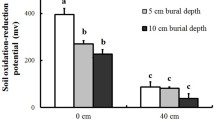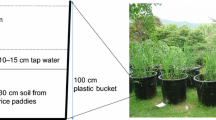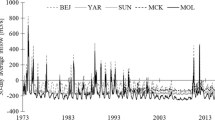Abstract
An important characteristic of many wetland plants in semi-arid regions is their capacity to withstand fluctuations between extended dry phases and floods. However, anthropogenic river regulation can reduce natural flow variability in riverine wetlands, causing a decline in the frequency and duration of deep flooding as well as extended droughts, and an increase in shallow flooding and soil saturation. Our aim in this paper was to use an experimental approach to examine whether reductions in flooding and drought disadvantage species adapted to both these extremes, and favours those with water requirements that match the new regime of frequent low-level flooding. We compared the growth characteristics and biomass allocation of three native Australian aquatic macrophytes (Pseudoraphis spinescens, Juncus ingens and Typha domingensis), which co-occur at Barmah Forest, south-eastern Australia, under three water treatments: drought, soil saturation and deep flooding. The responses of species to the treatments largely reflected changes in their relative abundance at Barmah Forest since river regulation. Typha domingensis, which has remained uncommon, performed relatively poorly in all treatments, while J. ingens, which has increased its range, exhibited more vigorous growth under soil saturation. Pseudoraphis spinescens, which was once widespread but has declined markedly in its distribution, grew strongly under all water treatments. These findings suggest that a return to more natural, variable river flow regimes can potentially be an important conservation and restoration strategy in ecosystems characterised by species that have adaptations to extreme hydrological growing conditions.







Similar content being viewed by others
References
Abel N, Roberts J, Reid J, Overton I, O’Connell D, Harvey J and Bickford S (2006) Barmah Forest: a review of its values, management objectives, and knowledge base. Report to the Goulburn Broken Catchment Management Authority. CSIRO Water for a Healthy Country Flagship, Canberra
Blanch SJ, Walker KF, Ganf GG (2000) Water regimes and littoral plants in four weir pools of the River Murray, Australia. Regulated Rivers 16:445–456
Bolger TP, Rivelli AR, Garden DL (2005) Drought resistance of native and introduced perennial grasses of south-eastern Australia. Aust J Agric Res 56:1261–1267
Bren LJ (1988) Effects of river regulation on flooding of a riparian red gum forest on the River Murray, Australia. Regulated Rivers 2:65–77
Bren LJ (1992) Tree invasion of an intermittent wetland in relation to changes in the flooding frequency of the River Murray, Australia. Aust J Ecol 17:395–408
Brock MA, Casanova MT (1997) Plant life at the edge of wetlands: ecological responses to wetting and drying patterns. In: Klomp N, Lunt ID (eds) Frontiers in ecology: building the links. Elsevier Science Ltd, Oxford, pp 181–192
Casanova MT (2011) Using water plant functional groups to investigate environmental water requirements. Freshw Biol 56:2637–2652
Catford JA, Downes BJ, Gippel CJ, Vesk PA (2011) Flow regulation reduces native plant cover and facilitates exotic invasion in riparian wetlands. J Appl Ecol 48:432–442
Chesterfield EA (1986) Changes in the vegetation of the river red gum forests at Barmah, Victoria. Aust For 49:4–15
Chong J, Ladson AR (2003) Analysis and management of unseasonal flooding in the Barmah–Millewa Forest, Australia. River Res Appl 19:161–180
Colloff MJ, Baldwin DS (2010) Resilience of floodplain ecosystems in a semi-arid environment. Rangeland J 32:305–314
Colloff MJ, Ward KW, Roberts J (2014) Ecology and conservation of grassy wetlands dominated by spiny mud grass Pseudoraphis spinescens in the southern Murray–Darling Basin, Australia. Aquat Conserv 24(2):238–255
Davidson AM, Jennions M, Nicotra AB (2011) Do invasive species show higher phenotypic plasticity than native species and, if so, is it adaptive? A meta-analysis. Ecol Lett 14:419–431
Dexter BD, Rose HJ, Davies N (1986) River regulation and associated forest management problems in the River Murray red gum forests. Aust For 49:16–27
Dudgeon D, Arthington AH, Gessner MO, Kawabata Z-I, Knowler DJ, Leveque C, Naiman RJ, Soto D, Stiassny MLJ, Sullivan CA (2006) Freshwater biodiversity: importance, threats, status and conservation challenges. Biol Rev 81:162–182
Edwards AL, Lee DW, Richards JH (2003) Responses to a fluctuating environment: effects of water depth on growth and biomass allocation in Eleocharis cellulosa Torr. (Cyperaceae). Can J Bot 81:964–975
Finlayson CM, Davidson NJ, Pritchard D, Milton GR, MacKay H (2011) The Ramsar convention and ecosystem-based approaches to the wise use and sustainable development of wetlands. J Int Wildl Law Policy 14:176–198
Greneli W, Weisner SEB, Sytsma MD (1992) Rhizome dynamics and resource storage in Phragmites australis. Wetlands Ecol Manage 1:247–293
Hudon C (2004) Shift in wetland plant composition and biomass following low-level episodes in the St. Lawrence River: looking into the future. Can J Fish Aquat Sci 61:603–617
Jansen A, Robertson AI (2001) Relationships between livestock management and the ecological condition of riparian habitats along an Australian floodplain river. J Appl Ecol 38:63–75
Lemly D, Kingsford RT, Thompson JR (2000) Irrigated agriculture and wildlife conservation: conflict on a global scale. Environ Manage 25:485–512
Lunt ID, Jansen A, Binns DL (2012) Effects of flood timing and livestock grazing on exotic annual plants in riverine floodplains. J Appl Ecol 49:1131–1139
Lytle DA, Poff NL (2004) Adaptation to natural flow regimes. Trends Ecol Evol 19:94–100
Mayence CE, Marshall DJ, Godfree R (2010) Hydrological and mechanical control for an invasive wetland plant, Juncus ingens, and implications for rehabilitating and managing Murray River floodplain wetlands, Australia. Wetlands Ecol Manage 18:717–730
McKenzie N, Coughlan K, Cresswell H (2002) Soil physical measurement and interpretation for land evaluation. CSIRO Publishing, Melbourne
MDBA (2010) Guide to the proposed basin plan, vol. 1: overview; vol. 2: technical background part ii appendices. Publication nos. 60 and 61/10. Murray–Darling Basin Authority, Canberra
MDBA (2012) Assessment of environmental water requirements for the proposed basin plan: Barmah–Millewa Forest. Publication No. 16/12. Murray–Darling Basin Authority, Canberra
Millennium Ecosystem Assessment (2005) Ecosystems and human well-being: current state and trends, vol 1. Island Press, Washington, DC
Newman S, Grace JB, Koebel JW (1996) Effects of nutrients and hydroperiod on Typha, Cladium, and Eleocharis: implications for Everglades restoration. Ecol Appl 6:774–783
Nicol JM, Ganf GG (2000) Water regimes, seedling recruitment and establishment in three wetland plant species. Mar Freshw Res 51:305–309
Nilsson C, Svedmark M (2002) Basic principles and ecological consequences of changing water regimes: riparian plant communities. Environ Manage 30:468–480
Peintinger M, Prati D, Winkler E (2007) Water level fluctuations and dynamics of amphibious plants at lake Constance: long-term study and simulation. Perspect Plant Ecol Evol Syst 8:179–196
Pittock J, Finlayson CM (2011) Australia’s Murray–Darling Basin: freshwater ecosystem conservation options in an era of climate change. Mar Freshw Res 62:232–243
Poff NL, Zimmerman JKH (2010) Ecological responses to altered flow regimes: a literature review to inform the science and management of environmental flows. Freshw Biol 55:194–205
R Development Core Team (2009) R: a language and environment. R Foundation for Statistical Computing, Vienna
Rasband W (1997–2009) ImageJ. National Institutes of Health, USE, Bethesda, MD. http://rsb.info.nih.gov/ij/
Raulings E, Morris K, Roache MC, Boon PI (2010) The importance of water regimes operating at small spatial scales for the diversity and structure of wetland vegetation. Freshw Biol 55:701–715
Ritchie JT (1981) Soil water availability. Plant Soil 58:327–338
Roberts J, Marston F (2011) Water regime for wetland and floodplain plants, a sourcebook for the Murray–Darling Basin. National Water Commission, Canberra
Rogers K, Saintilan N, Colloff MJ, Wen L (2013) Application of thresholds of potential concern and limits of acceptable change in the condition assessment of a significant wetland. Environ Monit Assess 185:8583–8600
Saintilan N, Rogers K, Ralph T (2013) Matching research and policy tools to scales of climate change adaptation in the Murray–Darling, a large Australian river basin: a review. Hydrobiologia 708:97–108
Smith MA, Rodgers JD, Dodd JL, Skinner QD (1992) Habitat selection by cattle along an ephemeral channel. J Range Manag 45:385–390
Stokes K, Ward K, Colloff MJ (2010) Alterations in flood frequency increase exotic and native species richness of understorey vegetation in a temperate floodplain eucalypt forest. Plant Ecol 211:219–233
Stromberg JC (2001) Restoration of riparian vegetation in the south-western United States: importance of flow regimes and fluvial dynamism. J Arid Environ 49:17–34
Stromberg JC, Lite SJ, Marler R, Paradzik C, Shafroth PB, Shorrock D, White J, White M (2007) Altered stream-flow regimes and invasive plant species: the Tamarix case. Glob Ecol Biogeogr 16:381–393
van der Valk AG, Squires L, Welling CH (1994) Assessing the impacts of an increase in water level on wetland vegetation. Ecol Appl 4:525–534
Vivian LM, Marshall DJ, Godfree RC (2014) Response of an invasive native wetland plant to environmental flows: implications for managing regulated floodplain ecosystems. J Environ Manage 132(1):268–277
Vörösmarty CJ, McIntyre PB, Gessner MO, Dudgeon D, Prusevich A, Green P, Glidden S, Bunn SE, Sullivan CA, Liermann CR, Davies PM (2010) Global threats to human water security and river biodiversity. Nature 467:555–561
Vretare V, Weisner SEB, Strand JA, Graneli W (2001) Phenotypic plasticity in Phragmites australis as a functional response to water depth. Ann Bot 69:127–145
Walker KF, Sheldon F, Puckridge JT (1995) A perspective on dryland river ecosystems. Regulated Rivers 11:85–104
Ward K (2005) Water management in the changing Barmah–Millewa wetlands. Proc R Soc Victoria 117:77–84
White SD, Deegan BM, Ganf GG (2007) The influence of water level fluctuations on the potential for convective flow in the emergent macrophytes Typha domingensis and Phragmites australis. Aquat Bot 86:369–376
Zedler JB, Kercher SM (2004) Causes and consequences of invasive plants in wetlands: opportunities, opportunists, and outcomes. Crit Rev Plant Sci 23:431–452
Zedler JB, Kercher SM (2005) Wetland resources: status, trends, ecosystem services, and restorability. Annu Rev Environ Resour 30:39–74
Acknowledgments
This work was supported by the CSIRO Water for a Healthy Country National Research Flagship. We thank Keith Ward (Goulburn-Broken Catchment Management Authority) for advice and assistance and staff of Parks Victoria and Department of Sustainability and Environment Victoria for research permits. We also thank four anonymous reviewers for providing feedback on earlier versions of the manuscript.
Author information
Authors and Affiliations
Corresponding author
Additional information
Communicated by R. Froend.
Rights and permissions
About this article
Cite this article
Vivian, L.M., Godfree, R.C., Colloff, M.J. et al. Wetland plant growth under contrasting water regimes associated with river regulation and drought: implications for environmental water management. Plant Ecol 215, 997–1011 (2014). https://doi.org/10.1007/s11258-014-0357-4
Received:
Accepted:
Published:
Issue Date:
DOI: https://doi.org/10.1007/s11258-014-0357-4




